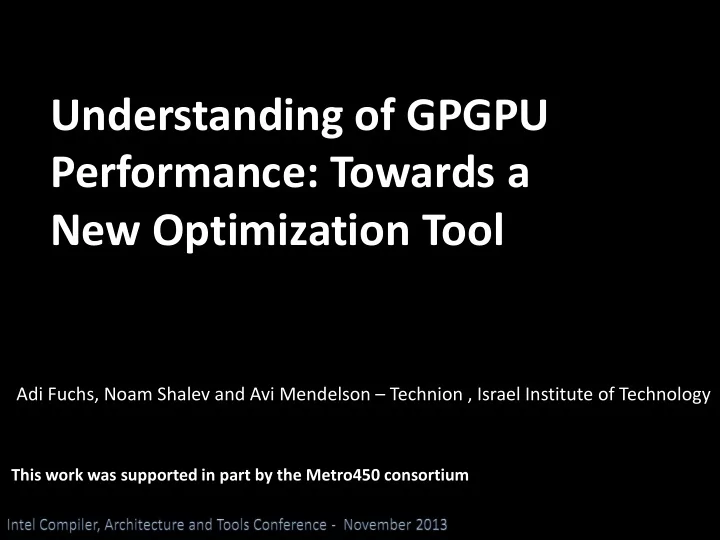

Understanding of GPGPU Performance: Towards a New Optimization Tool Adi Fuchs, Noam Shalev and Avi Mendelson – Technion , Israel Institute of Technology This work was supported in part by the Metro450 consortium
Adi Fuchs, Noam Shalev and Avi Mendelson – Technion , Israel Institute of Technology This work was supported in part by the Metro450 consortium
• GPU provide significant performance or power efficiency for parallel workloads • However, even simple workloads are microarchitecture and platform sensitive Bandwidth (in MB/s) for memory copy on two CPU, two GPU, and two 64-bit systems. • Why do applications behave the way they do?
Existing tools and work – Industry + Academia: • GPGPU Profiling tools: - complex and not conclusive - mainly based on companies ’ work (don ’ t expose undocumented behavior) • Academic work - some works suggest the use of targeted benchmarks - some target specific structures or aspects - many are based on “ common knowledge ”
Goals: Unveil GPU microarchitecture characterizations … Including undocumented behavior! Auto-match applications to HW spec + HW/SW optimizations
Current work We have a series of CUDA benchmarks that explore different NVIDIA cards Each micro-benchmark pinpoints a different phenomena We focus on the memory system – has a huge impact on performance and power Benchmarks executed on 4 different NVIDIA systems
Long term vision … We wish to construct an application + HW characteristics database Based on this database we would like to construct a matching tool: 1. Given a workload – what type of hardware should be used? 2. Given workload + hardware – what optimizations to apply?
Common microbenchmarks often target hierarchy (e.g. cache levels) Targeting hierarchy adds to the code ’ s complexity Targeting hierarchy harms portability! (machine dependent code ) Our micro-benchmarks target behavior, not hierarchy
4 systems tested:
Micro-benchmark #1: Locality Explore sizes of cacheline/prefetch using small jumps of varying size
Micro-benchmark #1: Locality In all systems tested shared memory is latency is fixed no caching/prefetching Shared Memory 100 90 80 70 Kernel Latency(us) 60 50 40 30 20 10 0 4 16 64 256 small jump size (bytes) C2070 Quadro2000 GTX680 K20
Micro-benchmark #1: Locality Texture memory caching is 32 bytes of size = 4 double precision coordinates Texture Memory 600 500 Kernel Latency(us) 400 300 200 100 0 4 16 64 256 small jump size (bytes) C2070 Quadro2000 GTX680 K20
Micro-benchmark #1: Locality Constant memory has a 2-level hierarchy for 64 and 256 byte segments Constant Memory 600 500 Kernel Latency(us) 400 300 200 100 0 4 16 64 256 small jump size (bytes) C2070 Quadro2000 GTX680 K20
Micro-benchmark #1: Locality Global memory – CUDA 2.x systems support caching / prefetching Global Memory 600 500 Kernel Latency(us) 400 300 200 100 0 4 16 64 256 small jump size (bytes) C2070 Quadro2000 GTX680 K20
Micro-benchmark #2: Synchronization Examine the effects of varying synchronization granularity for memory writes Number of thread changes as well - each thread executes the same kernel:
Micro-benchmark #2: Synchronization Fine-grained sync increase latency by 163%. 192 threads increase latency by 13% Fermi Quadro 2000 100 90 80 70 Kernel Latency (us) 60 50 40 30 20 10 0 1 4 16 64 256 1024 #Sync instructions 1 thread 4 threads 32 threads 64 threads 128 threads 192 threads
Micro-benchmark #2: Synchronization Fine-grained sync increase latency by 281%. 192 threads increase latency by 38% K20 90 80 70 60 Kernel Latency (us) 50 40 30 20 10 0 1 4 16 64 256 1024 #Sync instructions 1 thread 4 threads 32 threads 64 threads 128 threads 192 threads
Micro-benchmark #3: Memory Coalescing Target: the ability of grouping memory accesses from different threads … And what happens when it ’ s impossible. Each thread reads 1K lines starting from a different offset.
Micro-benchmark #3: Memory Coalescing Large offset = loss of locality. 192 threads+ Large offset = scheduler competition! Fermi Quadro2000 4bytes 8bytes 16bytes 32bytes 64bytes 128bytes 1.4 256bytes 512bytes 1024bytes 1.2 Average read latency (us) 1 0.8 0.6 0.4 0.2 0 1 2 4 8 16 32 64 128 256 #Threads
Micro-benchmark #3: Memory Coalescing No competition – however, overall latency is larger. Tesla K20 4bytes 8bytes 16bytes 32bytes 64bytes 128bytes 1.4 256bytes 512bytes 1024bytes 1.2 Average read latency (us) 1 0.8 0.6 0.4 0.2 0 1 2 4 8 16 32 64 128 256 #Threads
Other benchmarks...
Understanding GPUs performance + power = understanding microarchitecture! ... However microarchitecture is usually kept secret. Memory access patterns must be taken under considerations Loss of locality, resource competition , synchronizations significant side-effects Side-effects differ between GPU platforms (newer is not always better!)
Extend the focused benchmarks to other GPU ’ s aspects. Extend the work to analyze programs ’ behavior and correlate them with HW characterizations Extend the work to other platforms such as Xeon Phi
Extend the focused benchmarks to other GPU ’ s aspects. Extend the work to analyze programs ’ behavior and correlate them with HW characterizations Extend the work to other platforms such as Xeon Phi
Recommend
More recommend